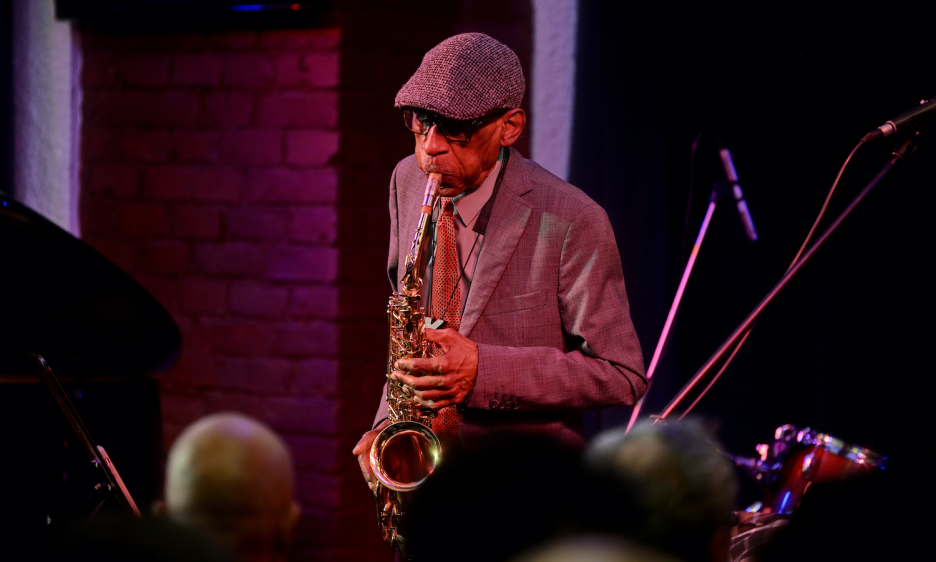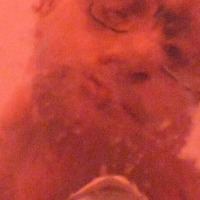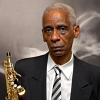Home » Jazz Articles » Live Review » Ostrava Days 2023
Ostrava Days 2023

Courtesy Martin Popelar
Ostrava, Czech Republic
August 28-September 2, 2023
Ostrava Days happens once every two years, mostly dedicated to the well-being of new music, composed for varying sizes of ensembles, right up to a fully-bloated orchestra. Sometimes, though, works will be penned for mere solo performers. It has always had extended ears for jazz, improvisation and electronic musics, as well as rock'n'roll being an increasingly strong influence on moderne composition, nowadays, injecting electric guitars into several ensembles.
The actual music festival runs for ten days, although it's preceded by an 'institute' section, a hotbed for rehearsal, discussion, development, lectures and seminars. Many composers and musicians are in residence for the entire 21-day span. Your scribe rode in on the industrially scenic four-hour train from Vienna, set for a climactic six days in Ostrava, this old coal-mining city, quite close to the Polish border.
Ostrava Days has an ongoing Czech-American character, as artistic director Petr Kotík dwells in NYC, and many of the festival's players and composers arrive from across the Atlantic. The Czech Republic contingent is also, of course, very significant, and there are many visitors from other European lands, and beyond.
One of the Ostrava nights was set in a jazz club, or at least a music joint that programmes such sounds as a key part of its diary. Roscoe Mitchell, famed as a founder of the Art Ensemble Of Chicago, was in town partially to oversee the orchestration of his old "Nonaah" work. Mitchell also got to perform in the way more intimate setting of Klub Parník, in duo with the pianist Amina Claudine Myers. She also presented one of her older works for large ensemble, two nights previously. Here, they were set to improvise together.
The large-scale concert at the Triple Hall Karolina had predictably overrun, so this 9.30pm show had become 10pm, and in reality, even later. Mitchell sat in his chair, visibly ready to play, staring the audience out, like an art installation in his readiness. Alto saxophone poised, Mitchell began, cutting isolated shapes of harshly repetitive hardness, diligently subjecting his constructions to a forensic analysis. Myers adopted a lighter, almost daintily walking approach, contrastingly. Patterns were amassed, Myers adding faint flashes of Thelonious Monk, while Mitchell persisted with his extremely austere tone. As it progressed, we couldn't exactly deem this pleasant, even if we were free jazz squall-heads. Mitchell's dogged repetition of his minimally selected notes began to bite. His core tone was becoming actively unpalatable. It's as if he was working out a melody in an excruciatingly slow fashion, while Myers plotted her own more variable course. Eventually, Mitchell removed his horn, and Myers spiralled into an involved solo expression, but after a short while, the saxophonist 'leader' turned to her, muttering about having played now for twenty minutes, rudely interrupting her flow. He'd finished, so now it was time for her to do the same.
Mitchell remained seated while a group of players took to the stage, made up of Ostravská Banda members (the festival's house outfit), with bassist James Ilgenfritz looking like he was the organisational spirit. In actuality, the New York vocalist Thomas Buckner was the governor, but he was unable to perform due to temporary medical advice. Instead, he attended as an audience member and emcee. Although it might not have been wise to fill the stage with would-be improvisers, these players did show some restraint in gradually opening up, and entering into the music, for self-edited spotlight stretches. Several of them appeared well-versed in free playing, although an equal several were hesitant in their vocabulary. One of the best articulators was the alto saxophonist, who actually prompted memories of the old Mitchell sound, until the man himself re-entered with further tonal-honk processes on the stairway to nowhere. Ilgenfritz provided some dynamic edges, and a silken-scratching acoustic guitarist was a positive provider, but the two singers just wouldn't go away. Katie Porter played bass clarinet, and another attending composer, Alvin Curran, sat at the piano, turning it into a sonically harpsichording beast. Overall, this was quite a vibrant performance, and the expanded group managed to ration their moves quite skilfully. Smaller permutations might have been better, but the evening still held the promise of a couple more keyboard solos.
Curran returned soon for a solo set, his presence only arranged earlier that same day, making hyper-minimalism repeats to formulate crosscurrents, sensitive speed-runs and internal overlaps. In a surreptitious way, Curran found himself in Birdland, making the transition radically to a more flowery jazz expression. He made his early reputation in Rome, during the mid-1960s, with the great (and very innovative) Musica Elettronica Viva, and Curran has continued to navigate the variegated sonic zones ever since.
Then Myers took the hot seat again, heading into gospel territory, closely partnering voice and keys. She wasn't a million miles away from an Alice Coltrane feeling, but also including the abstraction of Meredith Monk. "Steal away to Jesus," she breathed, completely captivating the by now late-night crowd.
As the Art Ensemble was one of the prime entry drugs to jazz when your scribe was a teenager, it pains him to write negatively about Roscoe Mitchell's offering, but such a state-of-play needs to be observed, especially following such a warmly anticipated gig...
Three days earlier, the programme was presented at the main Triple Hall Karolina space, an impressively transmogrified industrial building that has an appealing openness for a classical music venue. One winning feature is a slow-gradient floor-rise to the main performing space, with the entrance corridor running along a lower level. Already we are inhabiting an unusual structure. The performers are arranged around the almost-endless floorspace, with the audience seated on rising rows.
Since 2005, Ostravská Banda have been the resident ensemble of this festival, its players mostly drawn from the USA and the Czech Republic. There is a certain malleability about the group, its player pool possessing the instrumental resources for the many different sonic palettes that might be demanded by a composer. New works are frequently penned particularly with Ostravská Banda in mind, and subsequently premiered at this festival. This is also an actively touring unit.
OB gave a substantial concert of six works, most of them either premieres, very new, or recent pieces. An older work arrived from 2016, as George Lewis was in the house for his "Tales Of The Traveller," which climaxed the gig, and was pretty much the most impressive piece of the evening. Like Mitchell, Lewis has a strong background as a jazzer/improvisor, but he's been writing moderne-styled compositions for many years. Curiously, this particular work had a marked feeling of being a transcribed free improvisation, in contrast to many of the composer's works that include strong electronic elements. James Ilgenfritz played electric bass, but it was František Výrostko who provided the upright acoustic solo part, being The Traveller of the title. Electric guitar, flute, piano, violin, viola, cello, clarinets, trumpet and percussion made up the spread, encouraging a darkly swirling mystery, strings cooing out of the magical glister, rubbed surfaces abounding. Hand-prepared piano, deep vibraphone and frying cymbals came to dominance as Výrostko bowed out sweeping strafes, his presence becoming suitably dominant during the final sequences, Ilgenfritz by this time coated with a heavy fuzz.
Earlier, the frequently extreme Eric Wubbels provided the oldest work, "Auditory Scene Analysis (I), from 2014. Wubbels is also the pianist and co-director of the Wet Ink Ensemble, from NYC. Relatively conventional tonalities were savagely bookended by precise spurts of white noise, like a perverse form of palate-cleanser. This had a remarkable effect in relation to the preceding and following internal formations, ruminations for flute and vibraphone, until the delicate classicist beings in the audience rammed fingers back in ears as each sonic-snowburst took them by surprise. Soon, many members of the audience had fingers permanently inserted, not having thought to bring their earplugs for a gig such as this one. All throughout, singer Aneta Podracká Bendová was producing a voice narration that preferred individuality to tradition, adding a hyper-clipped sort of verbal punctuation.
Wubbels was also involved in the next night's gig at the Cathedral Of The Divine Saviour, as was Myers. Ostravská Banda were joined by Canticum Ostrava, for an extended three-part sequence of mostly choral works, however much such a concept could be gently subverted, in the name of new music. Wubbels was a mere performer on this night, playing the church organ and narrating a premiere of Anna Heflin's "Mythopoeia," eccentric, like soldiers singing in a bar, with distant organ, the Wubbels narration in German, along with another narration in an American accent, a non-meshing quality overwhelming the elaborate (or some would say sprawling) abundance of sonic overlaying. Not exactly a success.
Amina Claudine Myers led her own piece from 1978, "Improvisational Suite For Chorus, Pipe Organ And Percussion," which still sounded somewhat free 45 years later. The singer/composer played keyboard, and the choir was joined by Ilgenfritz on bass, and an extremely imaginative percussion duo of Chris Nappi and Martin Opršál. The massed vocal lines lent a Hollywood biblical quality, along with deep organ, gongs, and very resonant cymbals. Tympani rumbled beneath singing bowed bass, and a slow groove emerged, urged on by a flowing organ sustain. There were a few spotlight vocal parts, the first too weak, the second straying into incongruous opera stylings, a mood which continued, breaking the spiritual atmosphere. The percussion still provided continual pleasure. A pair of male singers came on, with the mission of scatting in the jazz fashion. Myers flicked a few pages of the score, appearing to edit her own work, which seemed to confuse the players, even though they swiftly adapted to the page-turning, submerging themselves in the improvisatory spirit.
Despite the presence of Canticum Ostrava, not all of the works presented sprang from the expected traditional foundation. The evening opened with the premiere of Michal Rataj's "Načálo Polunóščnici," which also featured organ, tympani, tubular bells and spatial electronics, with the Banda as one, dedicated to a hovering mass, particularly with its strings. There was a dramatic sculpting when the singers entered, creating a kind of religious exoticism, as the percussion ranged around the perimeter of the pews became increasingly active.
The second portion of this gig opened with a trio, performing "Orgaos," by Peter Graham. This was a blessed relief, as the tools involved were simply trumpet, organ and electronics, and the music unwound with the minimal nature often found on an ECM LP. Spirituality was still draped around the rafters, with a spectral sparseness, a subliminal sound of concrete being dragged slowly, these bass electronics matched with the trebly organ parts. The speaker system was at the very least quadraphonic, as your scribe had relocated to the rearmost rows. Franz Hautzinger's processed trumpet was perpetually subtle, but Ivan Palacký's electronics got steadily wilder. Klaus Lang's organ found its lower voices, curling across the digital bedrock.
The University Of Ostrava was used for the next evening's two-part presentation. Ensemble Garage came from Cologne, very much influenced by rock music, at least when selecting keyboards and electric guitars, and presumably encouraging this aspect in their commissioning strategy. Unfortunately, they did sound exactly like a bunch of classically- trained players attempting to rock out, with supposedly ironic group movements. The drumming was particularly stilted. Also, during a performance art audio-visual piece, there was a sense of overpowering cliché, and a lack of on-the-edge intensity required to pull off such tactics. The works in question were by Baldwin Giang and Brigitta Muntendorf. Matters improved as the various line-up permutations solidified into the entire Ensemble by the last two pieces. Acoustic guitarist Ondrej Veselý guested on James Helgeson's "September Music," often sounding like an oud player, with his spider-web traceries. Saxophone and clarinets were swapped around, framing the Veselý solos. "Föhnkrankheit" finished off, penned by Louis Wishart, and clearly influenced by progressive rock bombast, with big drums, cyclic repeats and weeping viola leading to climactic eruptions. Both of these compositions were global premieres by resident composers at the festival.
The second half concentrated on solo works, with some group pieces, including the composers Marc Sabat, Klaus Lang and Lisa Lim. There were two sheer highlights: "Aripiprazole Eternity" (Clancy Reynolds) and "A Piece That Is The Size That Is Recognised As Not A Size But A Piece" (Annesley Black).
The Reynolds work was performed by Ostravská Banda, backboned by a clanging anvil, with Veselý playing lap steel guitar, along with harp, alto saxophone, cello, trumpet, and a pair of oboes. There were shrill and groaning parts side-by-side, held reeds, dying moans, dissonant tones sustained over sharp anvil blows. The harp was strummed full-on, with it and the cello left seated while the other players formed a ritual circle to conclude with ringing power.
The 2013 Black composition was a solo endurance marathon by the pianist Daan Vandewalle, who played with highly intricate ramrod determination, up to 22 minutes, continually intensifying and climaxing, matching hyper-virtuosity with a ragged heads-down race to certain doom. Meanwhile, slides of diary/calendar entries revealed the composition's genesis and progress, strangely adhered to the in-the-room grittiness and resolve.
The Triple Hall Karolina concert that preceded the Klub Parník session had a couple of notable pieces, one of them a global premiere, the other a classic composition from 1989. Petr Ciger's brand new "Echolocations" opened up the show, and we all just knew that something special was in the offing, surveying the massed percussion gear set up at the left-hand side of the stage. This was an all-percussion section of Ostravská Banda, with your scribe seated closest to the array of Chris Nappi, which included a pair of upturned pots, bulbous cowbells and a bucket of water. It wasn't quite clear how much proximity counted, but Nappi seemed to be a central sonic leader amongst the quintet, although it might have sounded otherwise across the far end of the hall. Ringing cycles grew, becoming almost oppressive, as other, further-away stations activated their kick-drum thunder, and we certainly absorbed the four enormous gongs across the way. Nappi sunk his largest cowbell into the water, shifting its pitch steadily downwards, and the house resonated with naked joy upon being exposed to such hardcore percussive reverberations. The composition still held structure, but in a different language to that spoken by most pieces.
"Échange" opened the second half, a golden oldie from Iannis Xenakis. Gareth Davis took the bass clarinet solo role, investing it with quite a jazzed character, especially when playing completely alone. There were ranks of high oboes, flute and tuba, allied to a darkened drama of low tones, forcefully fanfaring their slow-process riffs.
The festival's penultimate day climaxed with The Long Night, which began at 5pm and continued until around 1am. This is actually quite a bit shorter than previous iterations, which used to run completely through the night until after breakfast-time. Even so, it still qualifies as a marathon. The new Plato gallery-venue provided ample space for metamorphosing seating-or-standing arrangements, as impromptu stage-areas revealed themselves for the next performances. First, the Fort Defiance, Navajo Nation composer Raven Chacon oversaw a selection of his short instrumental solo compositions (and one trio vocal work), most of which would surely be relatively inconsequential in isolation. Here, sewn together into an almost seamless procession, they took on another character, starting to sound like a unified single work, divided into sections.
Peter Ablinger's "Scales" involved no conventional musical instruments, and sat on the border with performance art, its interpreters rummaging in their own small clumps of discarded matter, from beer bottles to plastic tubs, file-binders to compact disc boxes. Many of these objects aren't blessed with tantalising sonic potential, so it was a battle to strike out with rounded authority. Most of the sounds were at the tinny, scratchy, rattling end of the spectrum. The Austrian Ablinger's works can be so diverse, your scribe previously witnessing his aggressive electro-noise outbursts. This was a scrappier mongrel, not so much sonically enthralling, but more of a conceptual happening, with most of the participants acting alone, before passing responsibility to the next, heavily reducing the possibility of chance interaction.
"Scales" was formulated between 1997 and 2022, while James Tenney wrote "In A Large, Open Space" in 1994. Gareth Davis returned on central bass clarinet, partnered by bowed vibraphone, oboe, trombone, violin and a second bass clarinet, engaged in well-shaped drones, the piece just like an old machine, ticking over following decades of sleep. The audience was invited to perambulate between the players, at a certain undefined point, probably when instinct grabbed a firm hold.
The final night took everyone back to Triple Hall Karolina for High Noon, a unified programme presentation dreamt up by Petr Kotík, accompanied by the festival manifesto, a rallying cry for the plight of new music on an old scene, and their desire to march onwards from such a dominant scenario. As it happens, all of the selected composers are over the age of 80, and all are blessed with agile cerebellums, open to sonic adventure. All five writers provided global premieres, with the mighty Ostrava New Orchestra spreading out to interpret these divergent pieces.
Anvils again! Alvin Curran's "'Na Rosetta" also featured the NH Ostrava Youth Basketball Club, who slapped their balls
Most of Phill Niblock's output favours electronic means, but it's a powerful experience to witness some of those textures, tones, techniques and layering, as interpreted by a large orchestra, mostly made up with strings. Niblock is often concerned with drone development, and "High Noon" (itself!) continued this fascination, beautifully crafted.
Roscoe Mitchell's orchestral version of his old "Nonaah" composition didn't sound very close to the original incarnation (although it was originally designed for solo alto saxophone), but achieved an epic stasis, with serial widescreen swelling, ordered via a democracy of equal instrumental prominences. It ended up increasingly agitated, marked by scurrying phrases, concluding the first part of the concert. Essentially,"Nonaah" has grown gradually down the decades since the 1970s, finally attaining surely its grandest state.
The second half continued the night's Stateside orientation with a long work by Christian Wolff, "For 38 Players." A fanfare circulation broke up the full airspace for the first ten minutes or so, with the bulk time spent in a harmonious and melodic universe, tympani dominant, and even alone for a while, to introduce a very smooth sense of suspension.
Pianist Daan Vandewalle returned for the closing "Outline/Fragment II," by Kotík himself. Vandewalle took over a section of the orchestra, conducting its sub-module actions, prompting the harp and percussion around his piano. The maverick parts existed more in the earlier phases of this 20 minute piece, with an active core of players, and then, following a restless tuba rousing, there was a morose conclusion, held within the extended string tones.
This was exactly the concert programme needed to climax the festival, as these starry veteran composers debuted striking new works on a massive scale, experimenting with the expansive resources of a full orchestral palette. Here's looking forward to the next Ostrava Days in 2025!
Tags
Live Review
Martin Longley
Czechia
Prague
Roscoe Mitchell
Amina Claudine Myers
Thelonious Monk
James Ilgenfritz
Alvin Curran
Alice Coltrane
George Lewis
PREVIOUS / NEXT
Support All About Jazz
 All About Jazz has been a pillar of jazz since 1995, championing it as an art form and, more importantly, supporting the musicians who make it. Our enduring commitment has made "AAJ" one of the most culturally important websites of its kind, read by hundreds of thousands of fans, musicians and industry figures every month.
All About Jazz has been a pillar of jazz since 1995, championing it as an art form and, more importantly, supporting the musicians who make it. Our enduring commitment has made "AAJ" one of the most culturally important websites of its kind, read by hundreds of thousands of fans, musicians and industry figures every month.































